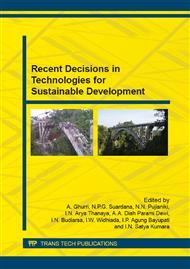p.277
p.282
p.289
p.294
p.300
p.309
p.313
p.319
p.325
Design of Fluidized Bed Co-Gasifier of Coal and Wastes Fuels
Abstract:
The solid waste produced from urban area is an urgent issue to be addressed. A fluidized bed (FB) gasification technology has been widely applied and proven effective to convert waste into clean energy and environmentally friendly. Co-gasification is a technique of mixing two or more fuels that aims to improve calorific value of the gas production. A FB gasifier reactor is designed using some previous experiments and available literature as well as from the internal experience of the research group. The gasification reactor pilot plant scale using data input of waste and biomass fuels has been fabricated with diameter of 0.7 m and a height of 1.5 m. The Tests have been performed showing that the FB gasifier is very feasible to be developed.
Info:
Periodical:
Pages:
300-306
Citation:
Online since:
July 2015
Keywords:
Price:
Сopyright:
© 2015 Trans Tech Publications Ltd. All Rights Reserved
Share:
Citation:


